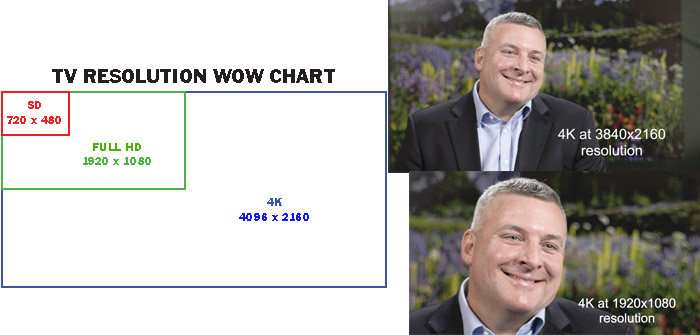(Photos above | Courtesy of Visual Thinking)
By now, most people are aware of the next stage in the development of video production and content delivery: 4K. For decades we watched Standard Definition or SD. The picture size, measured in pixels, was 720 x 480.
In the early 2000s, we graduated to two versions of High Definition, or HD: 720p (progressive) measured 1280×720, and 1080i (interlaced), measured 1920×1080. Now, along comes Ultra-High Definition (4K), measured 3840×2160, and 4K Cinema, measured 4096×2160.
The jump in picture quality from SD to HD was literally astonishing, in 2005 Visual Thinking Northwest was one of the first video production companies in Oregon to start producing content in HD. We had a contract with the Outdoor Channel, producing hunting and fishing videos in SD, and they loved our work.
When the network went to HD in 2005, they asked us to go along and we did. When we shot some test pictures of Mirror Pond with our new $85,000 Panasonic Varicam, one of our clients said the image was “just like looking out the window!” One has only to watch an SD show on an HD set to remember the difference in picture quality. And that was one of the reasons for such noticeable change; most of us went from a smaller, cube-like square screen TV to a large, flat 16×9 model. The transition was huge.
Now, there’s 4K. At 3840×2160, the 4K image is literally four times the resolution of HD (see illustration).
But, because we all now have big screen HD monitors, the difference in 4K resolution vs. HD resolution won’t be as dramatic to be sure, but it will be very noticeable depending on the picture content, and the equipment used to acquire the 4K images.
Unlike the early days of HD when only a couple cameras, one from Sony and one from Panasonic, had the ability to acquire HD pictures, and were ridiculously expensive ($85,000!), today, your cell phone can acquire 4K images, and they look pretty darn sweet on your phone. But, play back those images on a 4K monitor, and the compression algorithms used to squeeze them onto yourphones memory card don’t blow up to full-size well enough to make use of it commercially.
What’s this all mean for the business client? Because the bandwidth needed to transmit/carry 4K is substantially more than HD video, it’s unlikely that your local provider will be offering to air your commercials and videos in 4K any time soon. However, again because the resolution of 4K is literally four times that of HD, we have the ability to crop the 4K picture to either enhance a shot, or create a different shot altogether.
When doing an on-camera interview, for example, shooting in 4K but editing in HD will give you a wide shot and a close-up in the same shot. This is like having 2-camera shoot for the price of 1. Now, that’s a pretty good value, and it adds serious flexibility to your shoot. The same is true in aerials: if you shoot the aerials in 4K, you can literally zoom into a close-up of your subject matter with no loss of picture quality.
So, the next time you are shooting a new TV spot, YouTube or Corporate video, shoot in 4K and double your options. And yes, Visual Thinking Northwest has a beautiful 4K camera, and a 4K aerial platform.
Kevin Raichl, executive producer, 541-317-0619 office, 541-480-2355 cell, visual-thinking.com




